Alnitak, Zeta Orionis (ζ Ori), is the primary component in a triple star system with a combined apparent magnitude of 1.77. The blue supergiant star is the fifth brightest point of light in Orion, after Rigel, Betelgeuse, Bellatrix and Alnilam. The Zeta Orionis system lies at an approximate distance of 1,260 light years from Earth in the constellation Orion.
Alnitak is the easternmost star of Orion’s Belt, one of the best known asterisms in the night sky. It forms the familiar star pattern with the bright Alnilam and Mintaka. The three stars lie close to the celestial equator and are visible from most places on Earth. They form the hourglass-shaped constellation figure of Orion with Rigel, Betelgeuse, Bellatrix and Saiph.
Alnitak appears in the same line of sight as the bright emission nebula IC 434. It can be used to find several well-known deep sky objects, including the Flame Nebula (NGC 2024), the Horsehead Nebula (Barnard 33), and the reflection nebula Messier 78.
Star system
Zeta Orionis is a multiple star system consisting of at least three components. The visual component Alnitak A (Zeta Orionis A) is a close binary star, consisting of Alnitak Aa and Alnitak Ab. The two components are separated by 35.9 milliarcseconds and have an orbital period of 2,687.3 ± 7.0 days.
The third component, Alnitak B (Zeta Orionis B), lies at an angular separation of 2.728 arcseconds and takes 1,508.6 years to complete an orbit around Alnitak A.
Alnitak (Zeta Orionis Aa or Alnitak Aa) is the primary component in the Zeta Orionis system. The star is a hot blue supergiant with the stellar classification O9.5 Iab. With a mass 33 times that of the Sun, the supergiant star is a supernova candidate.
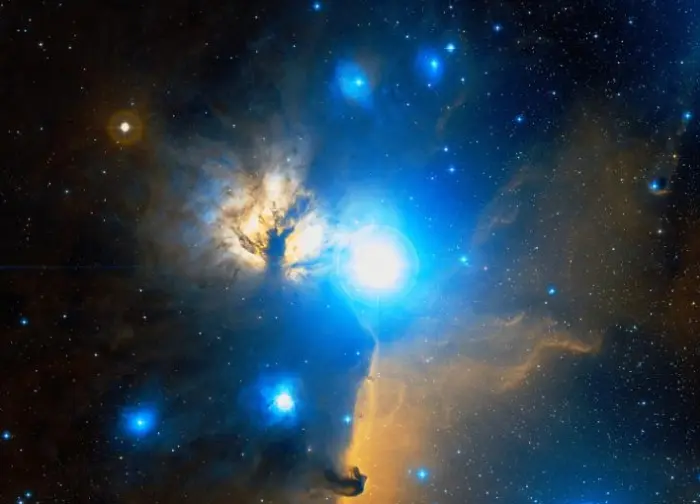
Alnitak (Zeta Orionis), image credit: ESO/Digitized Sky Survey 2 (CC BY 4.0)
With an apparent magnitude of 2.08, Alnitak is the brightest class O star in the sky. It has a radius of about 20 solar radii and a surface temperature of 29,500 kelvin. Shining with a luminosity of 250,000 Suns, Alnitak is one of the most intrinsically luminous stars visible to the unaided eye. It has an absolute magnitude of -6.0.
In spite of being a relatively young star at 6.4 million years of age, Alnitak Aa has already stopped fusing hydrogen in its core. The star will eventually evolve into a red supergiant, one like Betelgeuse, before going out as a supernova.
The close companion star, Zeta Orionis Ab (Alnitak Ab), has an apparent magnitude of 4.28. It is a hot blue subgiant star of the spectral type B1IV. Like Alnitak, the evolved star will go out as a supernova when it reaches the end of its life cycle. It has 14 times the Sun’s mass and a radius of 7.3 solar radii. With an effective temperature of 29,000 K and an absolute magnitude of -3.9, the star is 32,000 times more luminous than the Sun. It has an estimated age of 7.2 million years.
Alnitak Ab lies only 11 astronomical units from the primary component, which makes the pair a very close binary system. To illustrate, the distance from the Sun to Saturn is about 9.58 astronomical units.
The more distant companion, Zeta Orionis B (Alnitak B), is a hot blue giant star with the spectral class B0III. It shines at magnitude 4.01. It is believed to be 7 million years old. The star is an exceptionally fast spinner. It has a projected rotational velocity of 350 km/s.
Unlike Alnitak Ab, which can only be detected spectroscopically and interferometrically, Alnitak B can be resolved.
A fourth star, Alnitak C, can be seen in the vicinity of the system, but it is uncertain whether it is gravitationally bound to Zeta Orionis or merely lies in the same line of sight. It is a 9th magnitude star.
The Zeta Orionis stars belong to the Orion OB1 association (subgroup OB1b) and are members of the Collinder 70 open cluster. The stars of the Orion OB1b subgroup formed in the same molecular cloud at around the same time and share a common motion through space. They include the other two Orion’s Belt stars, Alnilam and Mintaka, and fainter stars in the same area. The Orion OB1 stellar association is part of the Orion molecular cloud complex, a large star forming region that contains mostly very young stars with ages of up to 12 million years.
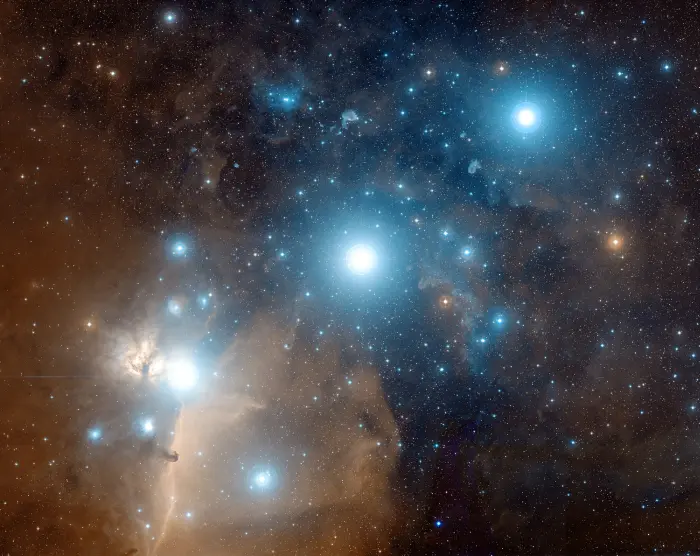
Orion’s Belt, image: Davide De Martin (http://www.skyfactory.org); Credit: Digitized Sky Survey, ESA/ESO/NASA FITS Liberator (PD)
Orion’s Belt
Alnitak forms the Belt of Orion, one of the most conspicuous asterisms in the sky, with its bright neighbours Alnilam and Mintaka. The three stars appear almost equally spaced in a line that stretches 2.3 degrees across. All three are evolved, massive stars that will go out as supernovae in the next few million years.
The stars of Orion’s Belt have had many different names across different cultures. In Arabic, they are known as Al Nijād (the Belt), Al Alkāt (the Golden Nuts) and Al Mīzān al Ḥaqq (the Accurate Scale Beam). Their English folk names include Peter’s Staff, Jacob’s Rod (Staff), the Yard-stick, the Golden Yard-arm, the Three Kings (the Magi), the Three Marys and Our Lady’s Wand.
In South America and Portugal, the three stars are known as “Las Tres Marías” (Spanish) and “As Três Marias” (Portuguese). In Puerto Rico and the Philippines, they are called “Los Tres Reyes Magos,” referring to the three Biblical Magi.
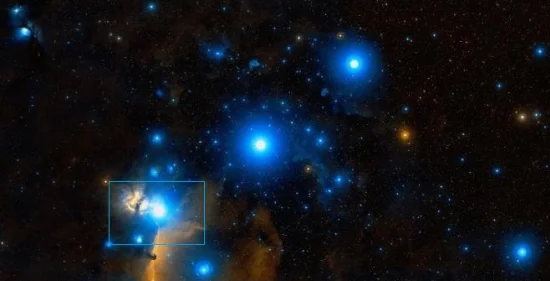
Alnitak and Orion’s Belt, image credit: ESO/Digitized Sky Survey 2 (CC BY 4.0)
In South America and Portugal, the three stars are known as “Las Tres Marías” (Spanish) and “As Três Marias” (Portuguese). In Puerto Rico and the Philippines, they are called “Los Tres Reyes Magos,” referring to the three Biblical Magi.
The Chinese know the Belt of Orion as the Weighing Beam. The three stars are part of as asterism known as Three Stars (參宿), formed by the Belt stars and other bright Orion stars: Betelgeuse, Rigel, Bellatrix and Saiph. Alnitak’s Chinese name is the First Star of Three Stars (參宿一), in reference to the asterism.
In antiquity, the stars of Orion’s Belt were part of ancient Egyptian culture as well. Orion and Sirius were associated with Osiris and his wife, and the gods were believed to have arrived from Orion’s Belt and Sirius to start the human race. According to the popular (but contested) Orion correlation theory, the pyramids at Giza were arranged to represent Orion’s Belt, and the air shafts were built to project the pharaoh’s soul toward Orion.
Orion’s Belt is best seen in mid-December, when it is at its highest in the sky, and in January at 9 pm.
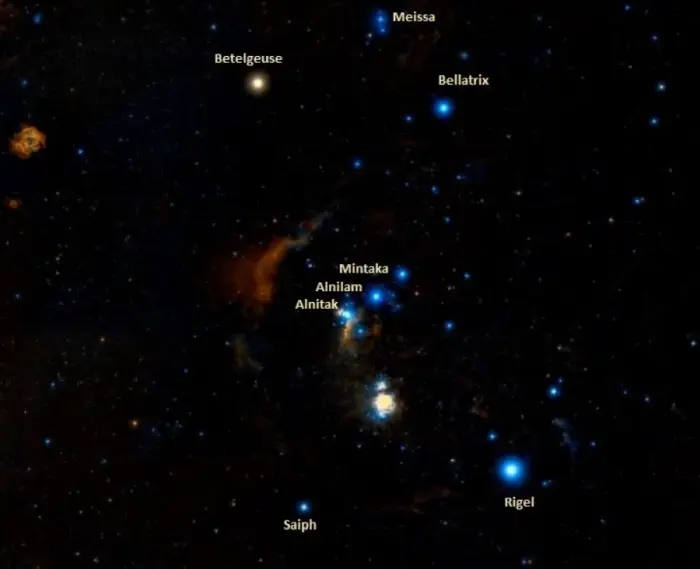
Orion stars, image credit: ESO/Digitized Sky Survey 2 (CC BY 4.0)
Facts
Alnitak is, on average, the 31st brightest star in the sky. It is about as bright as Alioth, the brightest star in Ursa Major. The two stars are only slightly fainter than Miaplacidus in the constellation Carina, Alnilam in Orion and Alnair in Grus, and they just outshine Mirfak in Perseus, Dubhe in Ursa Major and Regor in Vela.
Alnitak is the brightest O-type star in the sky. It narrowly outshines Regor (Gamma Velorum) in Vela and is also brighter than its Orion’s Belt neighbour Mintaka (Delta Orionis), as well as Naos (Zeta Puppis) in the southern constellation Puppis and Zeta Ophiuchi in Ophiuchus.
Located 1,260 light-years away, Alnitak is the 11th nearest O-type star to the Sun (including several subdwarf O stars). The nearest O-type star, Zeta Ophiuchi, is a blue main sequence star located 440 light-years away.
German amateur astronomer George K. Hunowsky reported Alnitak to be a double star in 1819. However, the blue supergiant was only recently found to have another companion. Scientists had suspected the presence of a close companion since the 1970s, when the star was observed with the Narrabri Stellar Intensity Interferometer, but the companion, Alnitak Ab, was not confirmed until 1998. It was discovered by a team from the Lowell Observatory in Flagstaff, Arizona.
Alnitak is surrounded by the bright emission nebula IC 434. Silhouetted against IC 434 is the famous dark Horsehead Nebula, which lies just south of Alnitak.
The nearby Flame Nebula (NGC 2024) is illuminated by the star’s strong ultraviolet light. The emission nebula is located just east of Alnitak.
Name
The name Alnitak (pronunciation: /ˈælnɪtæk/) comes from the Arabic an-niṭāq, which means “the girdle.” It was historically also spelled Al Nitak and Alnitah.
The name Alnitak was officially approved for the star Zeta Orionis Aa by the International Astronomical Union’s (IAU) Working Group on Star Names (WGSN) on July 20, 2016. Even though the name formally applies only to Zeta Orionis Aa, it is commonly used for the whole system and its other individual components (Alnitak Ab, Alnitak B).
Location
Alnitak is easy to find because it is both bright and part of a recognizable asterism. It is the eastern star of Orion’s Belt, appearing to the left of Alnilam and Mintaka to northern observers.
Orion’s Belt and the larger hourglass shape of Orion, outlined by the bright Betelgeuse, Bellatrix, Rigel and Saiph, can be seen from November to May in the early to late evening and from late July to November in the early morning hours. The constellation is particularly prominent in the sky during the northern hemisphere winter/southern summer. To southern observers, it appears upside down.
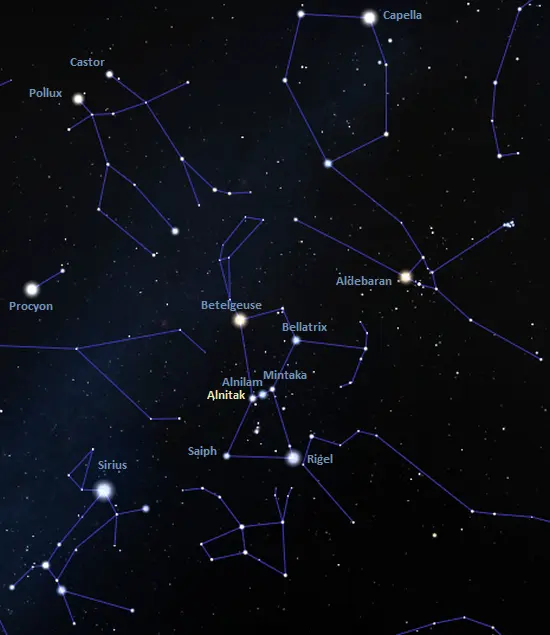
The location of Alnitak (Zeta Orionis), image: Stellarium
Alnitak can be used to find several well-known nebulae. The Flame Nebula (NGC 2024) is an emission nebula that appears next to the bright star. Like Alnitak, it is part of the Orion molecular cloud complex, a vast stellar nursery that stretches across most of the constellation Orion.
The emission nebula IC 434 is ionized by the intense light of Sigma Orionis, a multiple star system composed of several exceptionally hot, massive and luminous stars. The dark Horsehead Nebula (Barnard 33), one of the best-known dark nebulae in the sky, appears silhouetted against IC 434. The reflection nebula IC 435 and emission and reflection nebula NGC 2023 appear in the same area.
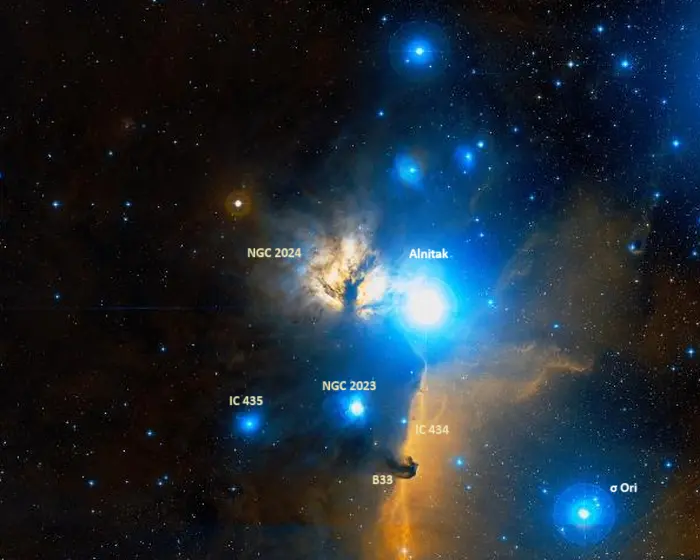
Alnitak, the Flame Nebula, the Horsehead Nebula, IC 434, IC 435 and NGC 2023, image credit: ESO/Digitized Sky Survey 2 (CC BY 4.0)
The bright reflection nebula Messier 78 (M78) lies 2 degrees north and 1.5 degrees east of Alnitak. It can be found at the intersection of the imaginary lines extended from Alnitak to Betelgeuse and from Sirius to Bellatrix.
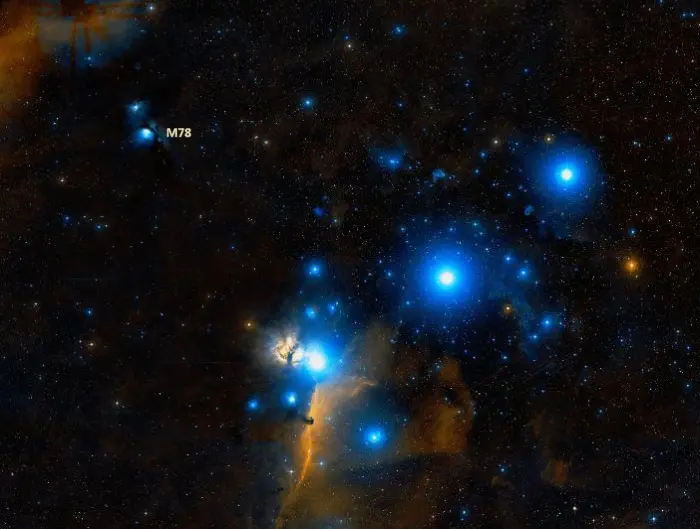
Alnitak and the reflection nebula Messier 78, image credit: ESO/Digitized Sky Survey 2 (CC BY 4.0)
Constellation
Alnitak is located in the constellation Orion. Representing the celestial Hunter in Greek mythology, Orion is the 26th largest of the 88 constellations. It occupies 594 square degrees of the sky on the celestial equator. The Hunter is also one of the brightest constellations in the night sky. It hosts more first and second magnitude stars than any other constellation.
Orion is one of the Greek constellations, catalogued by Claudius Ptolemy of Alexandria in his Almagest in the 2nd century CE. It is one of the oldest constellations, known to observers since prehistoric times.
Orion is best-known for the Belt of Orion, the bright and large Orion Nebula, and the first-magnitude supergiants Rigel and Betelgeuse, the seventh and 10th brightest stars in the sky.
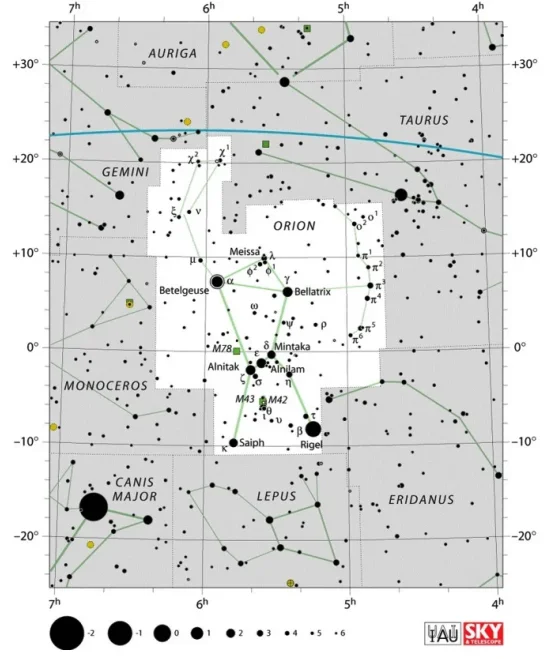
Orion constellation map by IAU and Sky&Telescope magazine (Roger Sinnott & Rick Fienberg) (CC BY 3.0)
The constellation Orion hosts many other exceptionally hot, massive and luminous stars. These include the blue supergiants Alnilam and Saiph, the blue bright giant Mintaka, the blue giants Meissa and Hatysa, and the luminous blue main sequence star Bellatrix.
Orion is a popular target for stargazers. The bright Orion Nebula (Messier 42), the nearest massive star forming region to Earth, is visible to the unaided eye on a clear night and can be observed in binoculars. The stellar nursery appears just south of Orion’s Belt.
Other notable deep sky objects in Orion include the emission nebulae Messier 43, Barnard’s Loop and the Flame Nebula (NGC 2024), the reflection nebula Messier 78, the dark Horsehead Nebula (Barnard 33), and the reflection nebula Sharpless 279 (Sh2-279), also known as the Running Man Nebula.
The best time of the year to observe the stars and deep sky objects in Orion is during the month of January, when the constellation is higher above the horizon in the early evening. Like all equatorial constellations, Orion is visible from virtually anywhere for at least part of the year. From the southern hemisphere, the constellation figure of the celestial Hunter appears upside down.
The 10 brightest stars in Orion are Rigel (Beta Ori, mag. 0.05 – 0.18), Betelgeuse (Alpha Ori, mag. 0.0 – 1.3), Bellatrix (Gamma Ori, mag. 1.59 to 1.64), Alnilam (Epsilon Ori, mag. 1.64 – 1.74), Alnitak A (Zeta Ori A, mag. 2.00), Saiph (Kappa Ori, mag. 2.09), Mintaka AB (Delta Ori AB, mag. 2.23), Hatysa (Iota Ori, mag. 2.77), Tabit (Pi3 Ori, mag. 3.16), and Eta Orionis (mag. 3.31 – 3.6).
Alnitak – Zeta Orionis
| Spectral class | O9.5Iab (or O9.2IbvarNwk) + B1IV + B0III (or O9.5II-III(n)) |
| U-B colour index | -1.06 |
| B-V colour index | -0.11 (A), -0.20 (B) |
| Apparent magnitude | 1.77 (2.08 + 4.28 + 4.01) |
| Absolute magnitude | −6.0 / −3.9 / −4.1 |
| Distance | 1,260 ± 180 light years (387 ± 54 parsecs) |
| Parallax | 4.43 ± 0.64 mas |
| Radial velocity | 18.50 ± 1.3 km/s |
| Proper motion | RA: 3.19 ± 0.59 mas/yr |
| Dec.: 2.03 ± 0.26 mas/yr | |
| Constellation | Orion |
| Right ascension | 05h 40m 45.52666s |
| Declination | -01° 56′ 33.2649” |
| Designations | Alnitak, Zeta Orionis, ζ Orionis, ζ Ori, 50 Orionis, 50 Ori, 126 G. Orionis, HIP 26727, SAO 132444, BD−02°1338, GC 7089, PLX 1301.00, PPM 400076, EM* MWC 509, MCW 349, JP11 1219, GSC 04771-01188, AKARI-IRC-V1 J0540454-015633, EUVE J0540-01.9, SKY# 9258, ROT 907, IRC +00081, GEN# +1.00037742, TD1 5127, TIC 11360636, WH 460, CEL 921, 2E 1500, 2E 0538.2-0157, AAVSO 0535-02, UBV 5783, XSS J05421-0225, 1RXS J054045.4-015631, uvby98 100037742, GSC 04771-01188, 1ES 0538-01.9, HGAM 467, IRAS 05381-0158, 2MASS J05404553-0156336, ADS 4263 AB, CCDM J05408-0156AB, WDS J05407-0157 |
| Alnitak A | Zeta Orionis A, ζ Orionis A, ζ Ori A, 50 Orionis A, 50 Ori A, HD 37742, HR 1948, TYC 4771-1188-1, STF 774A, ALS 14793, CGO 105, GCRV 3517, GOS G206.45-16.59 01, PMSC 05357-0200Aab, WEB 5270 |
| Alnitak B | Zeta Orionis B, ζ Orionis B, ζ Ori B, 50 Orionis B, 50 Ori B, HD 37743, HR 1949, GCRV 3518, TIC 712837934, TYC 4771-1188-2, STF 774B, ALS 16893, CGO 106, CSI-02 1338 1, GOS G206.45-16.59 02, PMSC 05357-0200B, WEB 5271 |
Alnitak Aa
| Mass | 33 ± 10 M☉ |
| Luminosity | 250,000 L☉ |
| Radius | 20.0 ± 3.2 R☉ |
| Temperature | 29,500 ± 1000 K |
| Surface gravity | 3.2 ± 0.1 cgs |
| Age | 6.4 million years |
| Rotational velocity | 110 ± 10 km/s |
| Rotation | 6.67 days |
Alnitak Ab
| Mass | 14 ± 3 M☉ |
| Luminosity | 32,000 L☉ |
| Radius | 7.3 ± 1.0 R☉ |
| Temperature | 29,000 K |
| Age | 7.2 Myr |
Alnitak B
| Age | 7 Myr |
| Rotational velocity | 350 km/s |